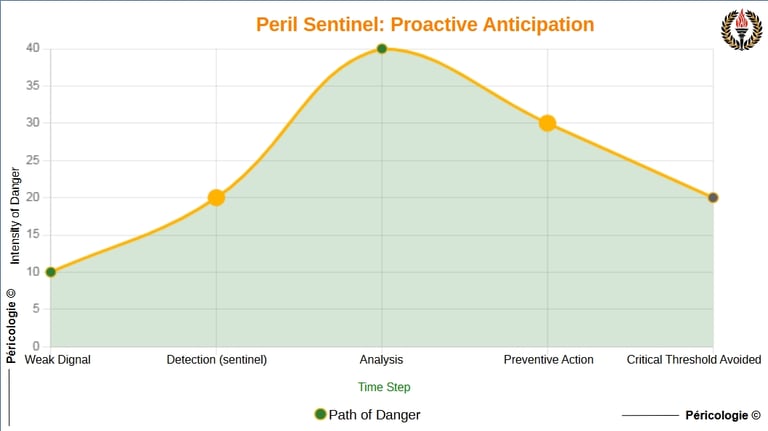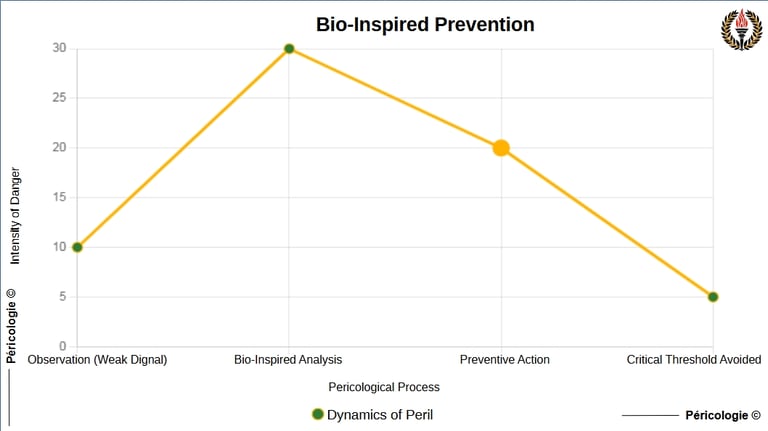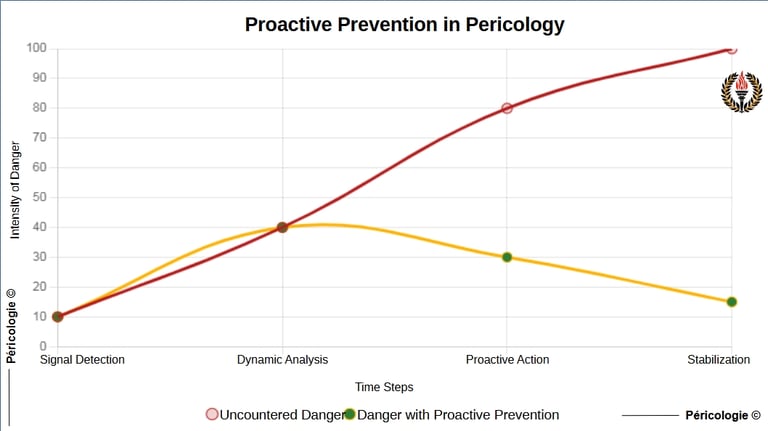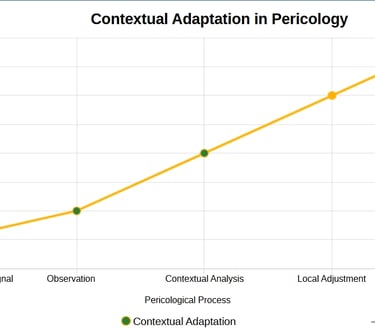The Foundations of Pericology
Sentinel of Perils
The "Sentinel of Perils" designates, in Pericology, the fundamental role of proactive and systemic monitoring of peril dynamics, whether biological, socio-cultural, technological or systemic. This concept embodies a peripheral vigilance, inspired by the cooperative dynamics of nature, which consists of detecting weak or measurable signals before they reach a tipping point. The Sentinel acts as a methodical observer, analyzing the underlying dynamics to propose preventive actions, in accordance with the slogan "See before, stop before". It does not react after the fact like traditional approaches, but anticipates to preserve essential balances.


Sentinel of Perils
Diagram of the Sentinel of Perils
Pericological Example
Context : In a rural community dependent on a river for irrigation, weak signals (abnormal flow variation) indicate an imminent risk of drought, amplified by intensive agricultural practices (positive loop). Traditional approaches would wait for a visible crisis (water shortage) to react, but Pericology acts upstream.
Pericological Application : As a Sentinel of Perils , a local pericologist observes measurable signals (flow, soil moisture) and draws inspiration from ecosystems (e.g., water redistribution in mangroves). He mobilizes farmers to adjust irrigation via micro-canals, preventing the tipping point (irreversible drought).
Etymology
Sentinel : From the Latin sentinella (16th century, via Italian), derived from sentire (“to feel, to perceive”), evoking an entity which perceives and alerts to imminent danger.
Perils : From the Latin periculum (“danger, risk”), central root of Pericology, highlighting a systemic threat to an equilibrium.
Pericological Sources
Peripheral Anticipation
"Peripheral Anticipation" is the founding approach of Pericology, consisting of identifying, observing and analyzing early signals of perils in a given environment, before they escalate or transform into a crisis. Inspired by the cooperative dynamics of nature, it mobilizes a comprehensive and proactive observation of systemic dynamics, whether human, biological or technological. Unlike reactive crisis management, it acts upstream to prevent critical thresholds, relying on weak and measurable signals, without presupposing perfect cooperation.


Peripheral Anticipation
Diagram of Peripheral Anticipation
Pericological Example
Context : In a coastal city, a local community relies on a mangrove ecosystem to protect its shores from erosion and storms. Historical data shows early signs of degradation (e.g., increased mangrove mortality due to saline pollution), but traditional indicators (e.g., water levels) do not yet signal an imminent crisis. Decision-makers risk ignoring these weak signals , amplifying a systemic peril (ecological collapse and flooding).
Pericological Application : By applying Peripheral Anticipation, inspired by bio-inspired dynamics (e.g., coral colonies detecting environmental stress via diffuse signals), Pericology mobilizes local sensors (e.g., salinity probes) and community observations to identify warning signals (e.g., anomalies in mangrove growth). A rapid analysis (via the Pericological Analyzer) identifies a potential critical threshold : saline accumulation threatens anecological tipping point. Proactive action (e.g., installation of biological filters inspired by ecosystem regulation mechanisms) is implemented to reduce salinity, blocking the peril before it reaches a crisis.
Etymology
Peripheral : Derived from the Greek péri ("around", "nearby") and phérō ("to carry"), implying all-encompassing vigilance around threatened systems.
Anticipation : From the Latin anticipare (“to act before”), emphasizing preventive action in the face of dangers.
Pericological Sources
https://lettres.tice.ac-orleans-tours.fr/php5/coin_eleve/etymon/geo/peripherie.htm
https://www.academia.edu/143727541/La_D%C3%A9sinformation_Amplifi%C3%A9e_par_l_IA?source=swp_share
https://www.seuil.com/ouvrage/la-methode-tome-1-edgar-morin/9782020042678
https://www.sciencedirect.com/science/article/pii/S0148296320301234
Bio-Inspired Prevention
"Bio-Inspired Prevention" is a central methodological approach of Pericology, which adapts the cooperative and adaptive dynamics observed in fauna and flora to anticipate and counter perils , mainly biological, before they reach critical thresholds. It relies on natural mechanisms of collaboration, self-management and feedback (such as negative stabilizing loops in ecosystems) to design intuitive, accessible and scientifically validated solutions. Unlike technocentric approaches, it favors simple strategies, not presupposing perfect human cooperation, but adapting to the practical realities of interconnected human, natural or technological contexts.


Bio-Inspired Prevention
Diagram of bio-inspired prevention
Pericological Example
Background : A project team in a technology company faces an emerging peril : work overload threatening a tipping point (collective burnout). Weak signals include recurring delays and degraded communication, detected via measurable indicators (e.g., increased error rate).
Pericology Application : Inspired by the cooperation of fish schools (e.g., redistribution of roles in the face of a predator), bio-inspired prevention offers a dynamic reorganization of tasks. The team adjusts its priorities in real time, redistributing workloads via collaborative micro-decisions, without waiting for centralized management.
Etymology
The term " Prevention " derives from the Latin praeventio ("action of anticipating, anticipating"), implying proactive action in the face of danger.
" Bio-Inspired " combines bio (from the Greek bios , "life") and inspired (from the Latin inspirare , "to blow into, to animate"), emphasizing an approach drawn from living processes.
Pericological Sources
Proactive Prevention
"Proactive Prevention" , within the framework of Pericology, refers to all methodical and anticipatory actions aimed at countering systemic perils before they reach a critical threshold, such as a tipping point. Anchored in the fundamental pillars of the discipline (observation, prevention, contextual adaptation), it relies on rigorous detection of warning signals, weak or measurable, to design interventions adapted to local and evolving dynamics. Inspired by bio-inspired regulatory mechanisms, proactive prevention favors practical and contextual solutions, avoiding prefabricated approaches. It mobilizes local actors to preserve human, environmental or technological balances, by anticipating emerging, invisible or diffuse perils.


Proactive Prevention
Proactive Prevention Diagram
Pericological Example
Context : In an interconnected food production plant, a weak signal (abnormal temperature fluctuation in a warehouse) is detected via IoT sensors. This signal, which is not critical in isolation, could trigger a chain reaction (e.g., product spoilage, logistics disruption), a systemic hazard amplified by the interconnectedness of the systems.
Pericological Application : Proactive Prevention, a pillar of Pericology, uses a bio-inspired approach (e.g., thermal regulation of beehives) to analyze the signal and act before the tipping point. Methodical action is implemented : automatic adjustment of cooling parameters and alert to local teams for inspection.
Etymology
Prevention : From the Latin praeventionem (from prae, "before", and venire, "to come"), literally meaning "to act before something happens".
Proactive : From the Latin prefix pro ("forward") and actio ("action"), implying voluntary and anticipated initiative, as opposed to passive reaction.
Pericological Sources
https://www.zengrc.com/blog/proactive-vs-reactive-risk-management-strategies/
https://www.sciencedirect.com/science/article/abs/pii/S0005796721000334
https://www.sciencedirect.com/topics/engineering/proactive-approach
https://www.health.org.uk/publications/proactive-approaches-to-safety-management
https://www.metricstream.com/insights/proactive-risk-management-approach.htms
Contextual Adaptation
"Contextual Adaptation", a fundamental pillar of Pericology, refers to the ability to adjust hazard prevention strategies and actions to the evolving specificities of local contexts, whether human, biological or technological. It involves methodical responsiveness to the changing dynamics of interconnected systems, drawing on rigorous observations and local data to design tailor-made solutions. Unlike standardized or prefabricated approaches, contextual adaptation mobilizes field knowledge and bio-inspired dynamics to anticipate and counter hazards before their tipping point.


Contextual Adaptation
Diagram of contextual adaptation
Pericological Example
Context : In a small farming community facing an emerging drought (systemic peril), weak signals (declining groundwater levels) are detected via local sensors. Local dynamics (clay soil, traditional irrigation practices) and interdependencies (farmers, river ecosystem) require an adapted response, avoiding generic solutions such as expensive water imports.
Periological Application : Inspired by the water regulation of mangroves (natural negative loop), Contextual Adaptation leads to a targeted redistribution of water resources via community micro-canals, adjusted to the clay soil, and to training farmers in drip irrigation techniques. This solution, co-constructed with local stakeholders, prevents the depletion of reserves before the tipping point (irreversible drought), while strengthening collective resilience.
Etymology
Adaptation : From the Latin adaptare ("to adjust, to conform"), formed from ad- ("towards") and aptare ("to make suitable, to adjust").
Contextual : From the Latin contextus ("fabric, connection"), derived from contexere ("to weave together").
Pericological Sources
For enthusiasts
Our links
Message
© 2025. All rights reserved. By Pericology
